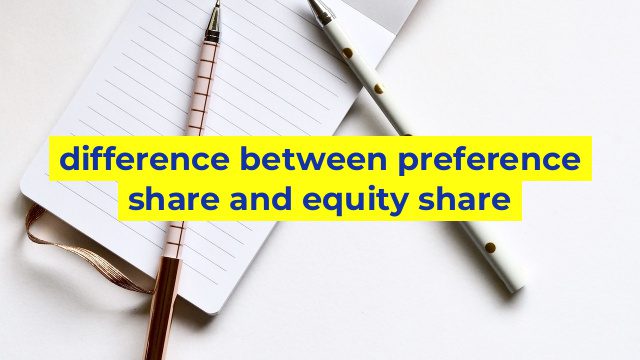Difference Between Preference Share and Equity Share
When it comes to investing in the stock market, choosing between preference share and equity share can be a crucial decision for investors. Although both the shares represent the ownership of the company, they differ in various ways. Here is a closer look at the differences between preference share and equity share.
Ownership
Equity shares represent the ownership of the company, which means that the shareholder is entitled to vote in the company’s meetings and have a say in important decisions made by the management. On the other hand, a preference share is a type of share that pays a fixed dividend to the holder but doesn’t give them voting rights.
Dividend Payment
Equity shareholders don’t have a predetermined dividend, which means that the amount of dividend paid to them depends on the company’s profits. If the company does not make profits, the equity shareholders may not receive a dividend. Whereas preference shareholders receive a fixed dividend that is predetermined and is paid to them before any dividends are paid to equity shareholders.
Risk and Returns
Equity shares are more risky than preference shares, as they have no guaranteed return. The dividends paid to equity shareholders depend entirely on the company’s profits and performance, and if the company performs poorly, the dividends paid to equity shareholders may be lower, or they may not receive any dividend at all. In contrast, preference shares have a fixed rate of return and are less risky than equity shares.
Redemption
Equity shares are permanent in nature and cannot be redeemed, whereas preference shares can be redeemable or non-redeemable. Redeemable preference shares can be redeemed by the company at a specific time or on a specific date.
Creditworthiness
Preference shares are seen as more creditworthy by lenders than equity shares. This is because preference shares are less risky than equity shares due to their fixed rate of return and their priority in the payment of dividends.
In conclusion, preference shares and equity shares have their own advantages and disadvantages, and therefore, investors need to carefully consider their investment objectives before making a decision. While preference shares offer fixed returns and are less risky, equity shares provide the opportunity for capital appreciation and voting rights. Consulting a financial advisor or doing thorough research can help investors make an informed decision.
Table difference between preference share and equity share
| Preference Share | Equity Share |
|---|---|
| Preference shareholders are entitled to receive a fixed dividend before any dividend is paid to equity shareholders. | Equity shareholders receive dividend after the preference shareholders are paid their fixed dividend. |
| Preference shareholders do not have voting rights or very limited voting rights. | Equity shareholders have voting rights in the management of the company. |
| Preference shares are less risky than equity shares. | Equity shares are more risky than preference shares. |
| Preference shareholders do not have ownership or control over the company. | Equity shareholders have ownership and control over the company as they are owners of the company. |
| In case of liquidation, preference shareholders are paid before equity shareholders. | Equity shareholders are paid after the preference shareholders in case of liquidation. |


